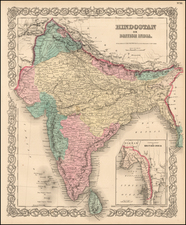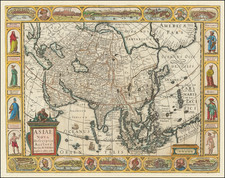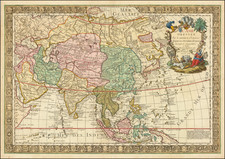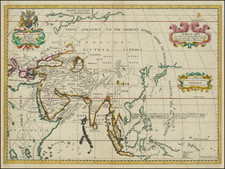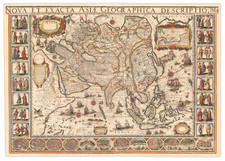The Beginning of the Carte-A-Figure Zeitgeist.
The First Folio Map of Asia with Decorative Borders.
Asiae Nova Descriptio Auctore Petre Kaerio excusum in aedibus auctoris, executed by Abraham Goos for Pieter van den Keere and issued from Amsterdam in 1614, stands as a pioneering representation of Asia, heralding the onset of the Carte-a-figure style. This first folio map of Asia adorned with decorative borders showcases eight figures in regional dress along its sides and features ten bird's-eye views of prominent cities, creating an intricate visual narrative of the continent's diverse cultures and major urban centers.
The early 17th century was a period of burgeoning exploration, trade, and cultural interchange, with European powers vying for dominance in Asia. This map embodies that zeitgeist, merging geographical exactitude with a rich tapestry of cultural depictions. The selection of cities—such as Aden, Jerusalem, Goa, and Macao—depicts vital nodes in the sprawling network of maritime trade routes and centers of political power and religious significance.
Pieter van den Keere's artistry transforms the map into a visual compendium of Asia's rich and varied cultures. The side borders, featuring figures such as the Mulier Tartarica and the Chynensis, and the top and bottom portraits like Rex Tartariae and Rex Chinae, serve as more than mere decoration. They encapsulate the diverse ethno-cultural tapestry of Asia, providing viewers an insight into the attire, status, and symbolism associated with various regions.
Similarly, the bird's-eye views of cities such as Calicut, Ormus, and Bantam highlight strategic ports and hubs of the spice trade, bearing testimony to the economic and geopolitical dynamics of the era. These detailed portrayals not only enhance the map's aesthetic appeal but also offer a nuanced understanding of the multifaceted relationship between geography, politics, commerce, and culture in early modern Asia.
Burden 182, provides important information regarding the engraver of the set and possible impetus for the preparation of the maps.
Van den Keere engaged Abraham Goos, his nephew, to engrave this decorative map of America. The idea could have been inspired by Blaeu's wall map of 1608 because the individual images all appear to be similar.
States
This is the first edition of the map. After the death of Pieter Van Den Keere's wife in the 1620s, he sold his plates to Claesz Janszoon Visscher, at which point they were modified to remove Kaerius's name and the date, and a host of new states were created into the 1650s.









![[Portrait] L'Asie.](https://storage.googleapis.com/raremaps/img/small/79746.jpg)
